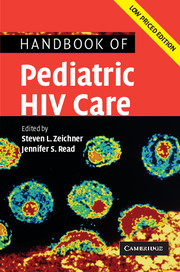Book contents
- Frontmatter
- Contents
- List of contributors
- List of abbreviations
- Foreword
- Preface
- Part I Scientific basis of pediatric HIV care
- Part II General issues in the care of pediatric HIV patients
- Part III Antiretroviral therapy
- Part IV Clinical manifestations of HIV infection in children
- Part V Infectious problems in pediatric HIV disease
- Part VI Medical, social, and legal issues
- 36 Medical issues related to the care of HIV-infected children in the home, daycare, school, and community
- 37 Contact with social service agencies
- 38 Psychosocial factors associated with childhood bereavement and grief
- 39 Legal issues for HIV-infected children
- Appendix 1 Formulary of antiretroviral agents
- Appendix 2 National Institutes of Health sponsored clinical trials for pediatric HIV disease
- Appendix 3 Selected HIV-related internet resources
- Appendix 4 Selected legal resources for HIV-infected children
- Index
- References
38 - Psychosocial factors associated with childhood bereavement and grief
Published online by Cambridge University Press: 23 December 2009
- Frontmatter
- Contents
- List of contributors
- List of abbreviations
- Foreword
- Preface
- Part I Scientific basis of pediatric HIV care
- Part II General issues in the care of pediatric HIV patients
- Part III Antiretroviral therapy
- Part IV Clinical manifestations of HIV infection in children
- Part V Infectious problems in pediatric HIV disease
- Part VI Medical, social, and legal issues
- 36 Medical issues related to the care of HIV-infected children in the home, daycare, school, and community
- 37 Contact with social service agencies
- 38 Psychosocial factors associated with childhood bereavement and grief
- 39 Legal issues for HIV-infected children
- Appendix 1 Formulary of antiretroviral agents
- Appendix 2 National Institutes of Health sponsored clinical trials for pediatric HIV disease
- Appendix 3 Selected HIV-related internet resources
- Appendix 4 Selected legal resources for HIV-infected children
- Index
- References
Summary
The tragedy of HIV/AIDS grows more profound as time passes [1]. The AIDS pandemic will cause a decline in life expectancy in 51 countries over the next two decades [2]. For each individual infected with the disease, many more are affected by the loss, including children, their parents, siblings, and caregivers. Disruptions to work patterns caused by absenteeism due to illness and funerals, the lack of physical space in morgues and burial grounds reach deep into everyday life, are a constant reminder of the fatal nature of this disease [3]. Populations are trying to exist in a state of daily and ongoing loss.
Bereavement, one of the most frequent life stressors impacting individuals infected with or affected by HIV [4], differs from grief related to other chronic illnesses. Those affected by HIV are typically exposed to multiple losses over a relatively short period of time, decreasing the likelihood that there will be adequate time to process and mourn each loss prior to the next death. One of the most potent barriers to successful mourning is the social stigma related to this disease [5]. The burden of secrecy further complicates the bereavement and subsequent healing process.
The grieving process may begin at the time of HIV diagnosis and is referred to as anticipatory grief [6]. People with HIV experience a wide range of losses other the imminence of death [7], including the loss of certainty, hopes for the future, relationships, health, control, sexual desirability and body image, status, dignity, privacy, and security.
- Type
- Chapter
- Information
- Handbook of Pediatric HIV Care , pp. 781 - 795Publisher: Cambridge University PressPrint publication year: 2006



